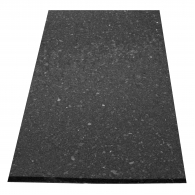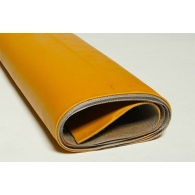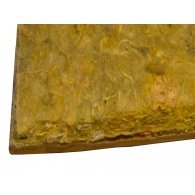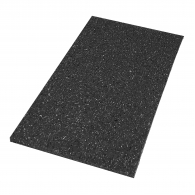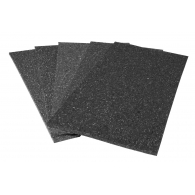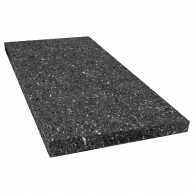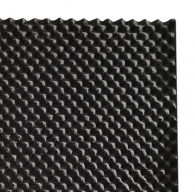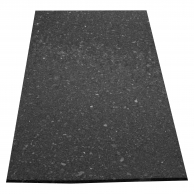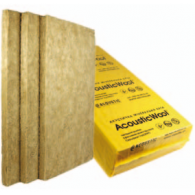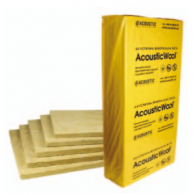Wall soundproofing
-
Macsound sound-absorbing vibration-proof soundproofing material. Consists of pieces of acoustic polyurethane foam, rubber, reinforcement fabric. It is a uniformly porous elastic material with an open small pore, due to which sound energy is absorbed and converted into thermal energy. Depending on th..$2.76
-
Heavy mineral soundproofing material 3 mm and with a density of 1900 kilograms per cubic meter It is characterized, first of all, by an increased volumetric weight and excellent viscoelastic properties, due to which the membrane is guaranteed to provide the maximum level of sound insulation, with a..$21.82
-
Heavy mineral soundproofing material 3 mm and with a density of 1900 kilograms per cubic meter It is characterized, first of all, by an increased volumetric weight and excellent viscoelastic properties, due to which the membrane is guaranteed to provide the maximum level of sound insulation, with a..$35.55
-
Macsound sound-absorbing vibration-proof soundproofing material. Consists of pieces of acoustic polyurethane foam, rubber, reinforcement fabric. It is a uniformly porous elastic material with an open small pore, due to which sound energy is absorbed and converted into thermal energy. Depending on th..DISCOUNT $5.33 -3% $5.17
-
Macsound sound-absorbing vibration-proof soundproofing material. Consists of pieces of acoustic polyurethane foam, rubber, reinforcement fabric. It is a uniformly porous elastic material with an open small pore, due to which sound energy is absorbed and converted into thermal energy. Depending on th..DISCOUNT $7.98 -3% $7.74
-
Macsound sound-absorbing vibration-proof soundproofing material. Consists of pieces of acoustic polyurethane foam, rubber, reinforcement fabric. It is a uniformly porous elastic material with an open small pore, due to which sound energy is absorbed and converted into thermal energy. Depending on th..DISCOUNT $10.66 -3% $10.34
-
Macsound sound-absorbing vibration-proof soundproofing material. Consists of pieces of acoustic polyurethane foam, rubber, reinforcement fabric. It is a uniformly porous elastic material with an open small pore, due to which sound energy is absorbed and converted into thermal energy. Depending on th..DISCOUNT $5.80 -3% $5.63
-
Macsound sound-absorbing vibration-proof soundproofing material. Consists of pieces of acoustic polyurethane foam, rubber, reinforcement fabric. It is a uniformly porous elastic material with an open small pore, due to which sound energy is absorbed and converted into thermal energy. Depending on th..DISCOUNT $7.98 -3% $7.74
-
Macsound sound-absorbing vibration-proof soundproofing material. Consists of pieces of acoustic polyurethane foam, rubber, reinforcement fabric. It is a uniformly porous elastic material with an open small pore, due to which sound energy is absorbed and converted into thermal energy. Depending on th..DISCOUNT $11.59 -3% $11.24
-
Macsound Prof - Sound-absorbing, vibration-proof, sound-proof material. Material sheet size: 1m x 0.5m, thickness 5mm. Consists of pieces of acoustic polyurethane foam, rubber, reinforcement fabric. It is a uniformly porous elastic material with an open small pore, due to which sound energy is absor..DISCOUNT $1.91 -3% $1.85
-
Macsound Prof - Sound-absorbing, vibration-proof, sound-proof material. Consists of pieces of acoustic polyurethane foam, rubber, reinforcement fabric. It is a uniformly porous elastic material with an open small pore, due to which sound energy is absorbed and converted into thermal energy. Dependin..DISCOUNT $3.80 -3% $3.69
-
Macsound Prof - Sound-absorbing, vibration-proof, sound-proof material. Material sheet size: 200 x 100 cm, thickness 5 mm. Consists of pieces of acoustic polyurethane foam, rubber, reinforcement fabric. It is a uniformly porous elastic material with an open small pore, due to which sound energy is a..DISCOUNT $7.60 -3% $7.37
-
Macsound sound-absorbing vibration-proof soundproofing material. Consists of pieces of acoustic polyurethane foam, rubber, reinforcement fabric. It is a uniformly porous elastic material with an open small pore, due to which sound energy is absorbed and converted into thermal energy. Depending on th..DISCOUNT $10.66 -3% $10.34
-
Macsound sound-absorbing vibration-proof soundproofing material. Consists of pieces of acoustic polyurethane foam, rubber, reinforcement fabric. It is a uniformly porous elastic material with an open small pore, due to which sound energy is absorbed and converted into thermal energy. Depending on th..DISCOUNT $21.33 -3% $20.69
-
Macsound sound-absorbing vibration-proof soundproofing material. Consists of pieces of acoustic polyurethane foam, rubber, reinforcement fabric. It is a uniformly porous elastic material with an open small pore, due to which sound energy is absorbed and converted into thermal energy. Depending on th..DISCOUNT $16.00 -3% $15.52
-
Macsound sound-absorbing vibration-proof soundproofing material. Consists of pieces of acoustic polyurethane foam, rubber, reinforcement fabric. It is a uniformly porous elastic material with an open small pore, due to which sound energy is absorbed and converted into thermal energy. Depending on th..DISCOUNT $31.99 -3% $31.03
-
Macsound sound-absorbing vibration-proof soundproofing material. Consists of pieces of acoustic polyurethane foam, rubber, reinforcement fabric. It is a uniformly porous elastic material with an open small pore, due to which sound energy is absorbed and converted into thermal energy. Depending on th..DISCOUNT $21.33 -3% $20.69
-
Macsound sound-absorbing vibration-proof soundproofing material. Consists of pieces of acoustic polyurethane foam, rubber, reinforcement fabric. It is a uniformly porous elastic material with an open small pore, due to which sound energy is absorbed and converted into thermal energy. Depending on th..DISCOUNT $42.66 -3% $41.38
-
Macsound sound-absorbing vibration-proof soundproofing material. Consists of pieces of acoustic polyurethane foam, rubber, reinforcement fabric. It is a uniformly porous elastic material with an open small pore, due to which sound energy is absorbed and converted into thermal energy. Depending on th..DISCOUNT $16.00 -3% $15.52
-
AcousticWool Sonet P acoustic mineral wool slabs based on basalt fibers are made from high-quality environmentally friendly raw materials produced exclusively in the EU countries. Acoustic and physical and mechanical properties of AcousticWool Concept depend on a complex set of factors, including: ..$15.75
-
Acoustic mineral wool AcousticWool Sonet P 50mm - 80 kg/m3, 1mx0.6m (3.6 m2/pack) color light yellowAcousticWool Sonet P acoustic mineral wool slabs based on basalt fibers are made from high-quality environmentally friendly raw materials produced exclusively in the EU countries. Acoustic and physical and mechanical properties of AcousticWool Concept depend on a complex set of factors, including: ..$7.88
-
AcousticWool® Floor - ness 20mm, density 120 kg / m3 (6.0 m2 / pack.) - rigid hydrophobized boards, manufactured made of acoustic mineral wool based on basalt breeds. Thanks to the laminar fiber orientation structure, the boards AcousticWool® Floor have lower dynamic rigidity density compared to ot..$4.27
-
AcousticWool Sonet, 48 kg/m3, acoustic mineral wool, (6.0 m2/pack) Application of acoustic mineral wool AcousticWool Sonet AcousticWool Sonet acoustic mineral wool increases the sound insulation of standard plasterboard partitions by 1.5-2 times and allows you to bring the soundproofing properties ..$3.77
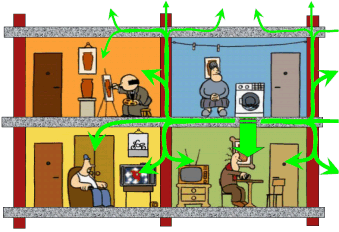
In modern homes, walls are an excellent conductor of sound vibrations.
This is especially pronounced in houses in which the interior partitions are made of concrete, gypsum or drywall.
In inexpensive options for new buildings, building codes that are in our state are often neglected.
As a result, we can purchase a room and eventually face the fact that for a quiet stay in it, it is necessary to soundproof it.
Quite often, it is enough to produce high-quality sound insulation of walls using high-tech materials and constructs in order to significantly reduce the noise level in it from sound sources from neighboring rooms.
During the construction of private houses, it is possible to think over and implement a project for soundproofing rooms from each other in advance, with a high result and minimal loss of space.
In practice, such wall soundproofing solutions are often used:
ADDITIONAL BRICK WALL.
The thicker the second wall, which needs to be attached close to the first, the higher the level of sound insulation will be.
Thick walls are found in the outer walls of some old house projects.
Street noise is practically not transmitted even through one thick wall.
Quite expensive in terms of the funds needed to build the wall, as well as in terms of the amount of floor space that the second wall will take, but still a very effective method.
BRICK WALL WITH INTERWALL FILLING.
By analogy with the previous method, a second brick wall is built at a distance of 5-15 cm from the first.
The gap between the walls is filled with Macsound prof sound-absorbing material, sound-proofing wool or other materials.
This option is more efficient than the first, but takes even more space.
ADDITIONAL DOUBLE WALL ON THE BASIS OF gypsum board
Even a drywall construction mounted on the main wall increases the degree of its sound insulation due to the mass of drywall.
In our opinion, the optimal solution for soundproofing walls, based on the factors of price, space occupied, the degree of soundproofing, is the following method of the so-called "sandwich":
From 2 layers of drywall sheets are mounted on the main wall at a distance of 5 to 30 centimeters between them.
The greater the distance between the drywall partitions, the higher the sound insulation coefficient.
Between the partitions in various versions are placed from two layers of soundproofing material.
To absorb resonance, use Macsound prof with a thickness of up to 10 millimeters.
For sound absorption, Macsound prof 40 m thick is used.
The degree of sound insulation of the wall will increase due to the different stiffness of the drywall sheets, if the double drywall sheets are of different thicknesses. For example 12 and 9 mm.
To obtain a high soundproofing result for walls, special vibration-proof fasteners should be used and all seams, cracks, and communication openings should be carefully sealed, so the nature of sound penetration is similar to the penetration of water into cracks and holes.
Soundproofing
Soundproofing is a crucial aspect of creating a comfortable and peaceful environment in any living or working space. It helps to block unwanted noise from entering a room, allowing individuals to focus, relax, and enjoy their surroundings without disturbance. One common area where soundproofing is often required is on walls, as they are a primary pathway for sound to travel through. Proper soundproofing of walls can make a significant difference in the overall acoustics of a room, providing a more serene and enjoyable atmosphere.
In the USA, soundproofing solutions for walls are widely available and come in a variety of options to suit different needs and budgets. There are several methods for soundproofing walls, each with its own benefits and considerations. One of the most common techniques is adding acoustic panels or foam to the walls, which can absorb sound waves and reduce echo. These panels are easy to install and come in a range of colors and designs to match the decor of any room.
Another popular method for soundproofing walls is using soundproofing insulation, such as fiberglass or mineral wool, which can be added to the walls during construction or renovation. This type of insulation helps to block sound transmission through the walls, creating a quieter and more comfortable environment. Additionally, double-layered drywall or mass-loaded vinyl can be installed to enhance the soundproofing of walls, providing an extra barrier against noise intrusion.
Soundproofing partitions, such as glass walls or dividers, can also be effective in reducing noise transfer between rooms or offices. By using double-glazed windows or acoustic-rated glass, sound can be minimized while still allowing light to pass through. Soundproof curtains or drapes can further enhance the soundproofing of partitions, creating a more private and peaceful space for individuals to work or relax.
When considering soundproofing solutions for walls or partitions, it is important to consult with a professional to determine the best options for your specific needs. A soundproofing specialist can assess the acoustics of a room, identify areas of sound leakage, and recommend the most effective soundproofing products for the desired outcome. By investing in proper soundproofing of walls and partitions, individuals can create a more tranquil and enjoyable environment, free from unwanted noise and distractions.

